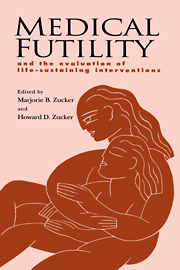Book contents
- Frontmatter
- Contents
- Preface
- Foreword
- Contributors
- 1 Medical futility: a useful concept?
- 2 Death with dignity?
- 3 Physicians and medical futility: experience in the critical care setting
- 4 Physicians and medical futility: experience in the setting of general medical care
- 5 Futility issues in pediatrics
- 6 Medical futility: a nursing home perspective
- 7 Alternative medicine and medical futility
- 8 How culture and religion affect attitudes toward medical futility
- 9 When religious beliefs and medical judgments conflict: civic polity and the social good
- 10 Conflict resolution: experience of consultation-liaison psychiatrists
- 11 Ethics committees and end-of-life decision making
- 12 The economics of futile interventions
- 13 Medical futility: a legal perspective
- 14 Professional and public community projects for developing medical futility guidelines
- 15 Community futility policies: the illusion of consensus?
- 16 Not quite the last word: scenarios and solutions
- Index of cited authors, cases, and statutes
- Subject index
10 - Conflict resolution: experience of consultation-liaison psychiatrists
Published online by Cambridge University Press: 11 September 2009
- Frontmatter
- Contents
- Preface
- Foreword
- Contributors
- 1 Medical futility: a useful concept?
- 2 Death with dignity?
- 3 Physicians and medical futility: experience in the critical care setting
- 4 Physicians and medical futility: experience in the setting of general medical care
- 5 Futility issues in pediatrics
- 6 Medical futility: a nursing home perspective
- 7 Alternative medicine and medical futility
- 8 How culture and religion affect attitudes toward medical futility
- 9 When religious beliefs and medical judgments conflict: civic polity and the social good
- 10 Conflict resolution: experience of consultation-liaison psychiatrists
- 11 Ethics committees and end-of-life decision making
- 12 The economics of futile interventions
- 13 Medical futility: a legal perspective
- 14 Professional and public community projects for developing medical futility guidelines
- 15 Community futility policies: the illusion of consensus?
- 16 Not quite the last word: scenarios and solutions
- Index of cited authors, cases, and statutes
- Subject index
Summary
Medical futility often stimulates intense conflicts among medical/surgical patients, their families or surrogates, health care staff, medical–legal–financial systems, and ethical standards, including the allocation of scarce resources. These conflicts may be particularly intense when the patient is uncooperative or provocative (Groves 1979). Consultation-liaison (C/L) psychiatrists frequently are asked to help resolve such conflicts. The C/L psychiatrist is a member of the medical/surgical team who works directly with the patient and his doctor (i.e., consultation) and also influences the team's decisions through interactions with the rest of the patient's caretakers (i.e., liaison).
Specifically, the C/L psychiatrist (Strain and Grossman 1975):
Identifies patients at risk of or evidencing psychiatric or psychosocial difficulty
Treats patients in conjunction with the medical/surgical/nursing team
Suggests appropriate follow-up and aftercare of psychiatric problems
Addresses staff conflict(s) over patient care
Because of their background and experience in understanding human behavior, C/L psychiatrists are accustomed to dealing with conflicts relating to medical futility. Although each medical situation is unique, situations of futility have in common that the individuals involved have been deprived of a basic emotional tool, that of taking action. Being able to act effectively in the world provides a person with an outlet for aggression and is associated with feelings of confidence, self-esteem, independence, and safety. When effective action is impossible, as in a situation of medical futility, the individual may feel frustrated, angry, and vulnerable. Conflicts involving aggression frequently surface strongly.
- Type
- Chapter
- Information
- Medical FutilityAnd the Evaluation of Life-Sustaining Interventions, pp. 98 - 109Publisher: Cambridge University PressPrint publication year: 1997

